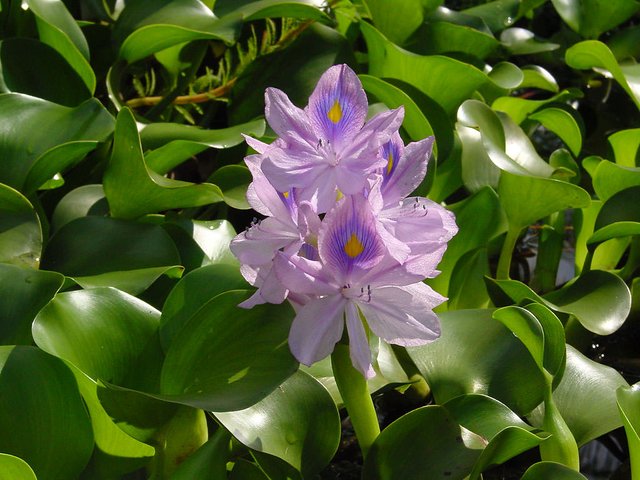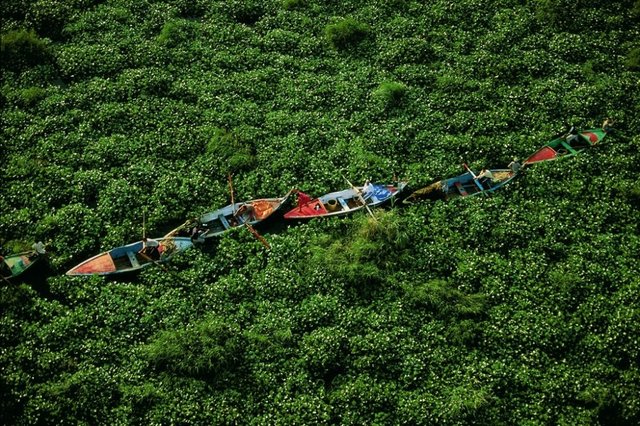Uses of Water Hyacinth in Agriculture: Fertilizer [EN DE ES]
Hello everyone.
Water Hyacinth (Eichornia crassipes) has become a major problem in many parts of the world, due o its reproduction rate.
As a consequence irrigation channels are fouled, freight ships and fishing boats alike are hindered, the quality of drinking water is affected and fish stocks are reduced.
In this series I will be posting about different uses for water hyacinth.

As mulch:
Mulch takes advantage of the high water content of water hyacinth. It improves the soil structure, more so than compost. Maintains moisture levels because evaporation is prevented. It prevents erosion and weeds
Its degree of success depends very much on the crop.
Because water hyacinth has a low nitrogen content, an additional source of nitrogen may be required. Extra nitrogen can be provided by planting a leguminous or by rotating with a leguminous crop such as beans.
As compost:
The warm climate of tropical countries might be ideal for producing compost.
Its benefits are: provides a source of humus. It contains many trace elements, rarely found in synthetic fertilizers, thus it helps plants be more disease resistant.
It has fewer infectious organisms than mulch. Even though it doesn’t increase yield, it can maintain the productivity of the soil. However it doesn’t always destroy the seeds of weeds nor the bacteria responsible for plant diseases
Significant advantages over fertilizer: nutrients aren’t leached out by rain water. Because the nutrients aren’t leached out by rain water they cannot therefore enter the drainage systems, rivers and lakes, unlike synthetic fertilizers, therefore they don’t encourage further infestation of water hyacinth.
As ash:
It is the easiest form of fertiliser when it comes to transportation. Because of its high potassium content it shouldn’t be used on crops that have a high salt content. It is better for large plants. It is particularly recommended for ground nuts, especially if the soil is low on nutrients.
Nutzung von Wasserhyazinthe in der Landwirtschaft: Düngemittel
Moin!
Die Wasserhyazinthe (Eichornia crassipes) ist in vielen Teilen der Welt aufgrund ihrer Reproduktionsrate zu einem großen Problem geworden.
Dadurch werden Bewässerungskanäle verschmutzt, Frachtschiffe und Fischerboote behindert, die Qualität des Trinkwassers beeinträchtigt und die Fischbestände reduziert.
In dieser Artikelserie werde ich über verschiedene Anwendungen von Wasserhyazinthe posten.

Als Mulch:
Mulch nutzt die Vorteile des hohen Wassergehalts der Wasserhyazinthe.
Die Bodenstruktur wird verbessert, mehr noch als der Kompost. Es hält den Feuchtigkeitsgehalt aufrecht, da Verdunstung verhindert wird. Es verhindert Erosion und Unkrautbildung, Ihr Wirkungsgrad hängt sehr stark von der Ernte ab.
Da die Wasserhyazinthe einen niedrigen Stickstoffgehalt hat, kann eine zusätzliche Stickstoffquelle erforderlich sein. Zusätzlicher Stickstoff kann durch Anpflanzen einer Hülsenfrucht oder durch Rotation mit einer Hülsenfrucht wie z.B. Bohnen gewonnen werden.
Als Kompost:
Das warme Klima der tropischen Länder könnte optimal für die Kompostproduktion sein.
Seine Vorteile sind: es bietet eine Quelle von Humus. Es enthält viele Spurenelemente, die in synthetischen Düngemitteln selten vorkommen, und hilft so Pflanzen, widerstandsfähiger gegen Krankheiten zu werden.
Es hat weniger infektiöse Organismen als Mulch. Auch wenn es den Ertrag nicht erhöht, kann es die Produktivität des Bodens aufrechterhalten. Es zerstört jedoch nicht immer die Samen des Unkrauts und die Bakterien, die für Pflanzenkrankheiten verantwortlich sind.
Signifikante Vorteile gegenüber Dünger: Nährstoffe werden nicht durch Regenwasser ausgelaugt. Da die Nährstoffe nicht durch Regenwasser ausgelaugt werden, können sie im Gegensatz zu synthetischen Düngemitteln nicht in die Entwässerungssysteme, Flüsse und Seen gelangen und fördern somit keinen weiteren Befall von Wasserhyazinthe.
Als Asche:
Es ist die einfachste Form des Düngers beim Transport. Wegen seines hohen Kaliumgehalts sollte es nicht für Pflanzen mit hohem Salzgehalt verwendet werden. Es ist besser für große Pflanzen. Es wird besonders für gemahlene Nüsse empfohlen, besonders wenn der Boden nährstoffarm ist.
Usos del jacinto de agua en la agricultura: Fertilizante
Buenas
El jacinto de agua o camalote (Eichornia crassipes) se ha convertido en un problema importante en muchas partes del mundo, debido a su capacidad de reproducirse.
Como consecuencia de ello, se ensucian los canales de irrigación, los buques de carga y los barcos pesqueros se ven obstaculizados, la calidad del agua potable se ve afectada y se reducen las poblaciones de peces.
Voy a escribir sobre los diferentes usos del jacinto de agua.
Como mantillo:
El mantillo aprovecha el alto contenido de agua del jacinto acuático.
Mejora la estructura del suelo, más que el abono.
Mantiene los niveles de humedad porque se evita la evaporación
Previene la erosión y las malas hierbas
Su éxito depende en gran medida del cultivo.
Debido a que el jacinto acuático tiene un bajo contenido de nitrógeno, puede ser necesaria una fuente adicional de nitrógeno. Se puede proporcionar nitrógeno adicional plantando una leguminosa o rotando con un cultivo de leguminosas como los frijoles.
Como abono:
El clima cálido de los países tropicales podría ser ideal para producir abono orgánico.
Sus beneficios son: aporta una fuente de humus. Posee muchos oligoelementos, raramente encontrados en los fertilizantes sintéticos, por lo tanto ayuda a las plantas a ser más resistentes a las enfermedades.
Además Tiene menos organismos infecciosos que el mantillo. Aunque no aumenta el rendimiento, puede mantener la productividad del suelo. Sin embargo, no siempre destruye las semillas de las malas hierbas ni las bacterias responsables de las enfermedades de las plantas.
Notables ventajas sobre los fertilizantes: el agua de lluvia no dispersa los nutrientes. Debido a que los nutrientes no son filtrados por el agua de lluvia, no pueden entrar en los sistemas de drenaje, ríos y lagos, a diferencia de los fertilizantes sintéticos, por lo que no fomentan una mayor contaminación del jacinto acuático.
Como ceniza:
Es el fertilizante más fácil de transportar. Por su alto contenido en potasio no debe utilizarse en cultivos con alto contenido en sal. Es mejor para plantas grandes. Se recomienda especialmente para las nueces molidas, sobre todo si el suelo es pobre en nutrientes.
More information and other sources:
Weitere Informationen und Quellen:
Fuentes:
[Lindsey, Hirt. Use water hyacinth!] (https://www.goodreads.com/book/show/34909347-use-water-hyacinth)